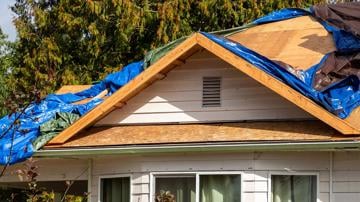If your roof is damaged in a storm, you may not be able to have a professional roofer come and fix it straight away. So, knowing how to make temporary repairs yourself can be a very useful skill.
Safety
Safety should be your first priority before contemplating doing anything to your roof. The last thing you want is to fall or drop something on someone below, so it pays to bear the following safety tips in mind:
• Make sure you have a sturdy ladder that reaches your roof, with several feet to spare. Anchor it firmly at the bottom on level ground and climb up or down it with both hands firmly on the rails.
• If you are taking tools and materials up onto the roof, make sure that they are securely stowed away from the edge.
• Wear sturdy boots with good grip and choose your footing carefully at all time, walking along joins, rather than on the roof itself.
Insurance
If your roof has been damaged due to a storm, bear in mind that you will be making a claim with your insurance company, so take photographs of the damage before undertaking any temporary repairs. Ideally, call your home insurance company as soon as possible after the damage occurs, but if they are unable to send an assessor to look at it immediately and there is likely to be more bad weather, then you should proceed with your repairs.
Repairs
The repairs you are able to make will depend on the type of roof you have and the extent of the damage incurred.
The following are some general repair tips that may come in handy:
- If the roof is leaking into the ceiling because of the damage, you will need to locate the wet patch and either access it via the man hole, or drill a small hole in the ceiling to prevent it from pooling and allow it to drain.
- Roofing cement and putty can both be useful for a variety of repairs, but you must make sure the area is dry and clean before applying. A portable hair dryer can be useful in such situations.
- If the damage is greater than a few missing tiles or shingles, you may need to apply a patch to the affected area. A square of plywood nailed over the hole can often keep the weather out until proper repairs can be made.
- If the damage is extensive, you may need to abandon the idea of repairing it and cover it instead with a tarpaulin or plastic sheeting. Be sure to secure it firmly, particularly if more bad weather is expected.
Such temporary repairs are far from ideal, but in an emergency, they can help prevent secondary damage from occurring. Water damage can cause all sorts of problems with electrics and even structural integrity, so if it’s an emergency and there’s something you can safely do, then it could be in your best interests to give it a go.




